
1University Business School, Panjab University, Chandigarh, India

Creative Commons Non Commercial CC BY-NC: This article is distributed under the terms of the Creative Commons Attribution-NonCommercial 4.0 License (http://www.creativecommons.org/licenses/by-nc/4.0/) which permits non-Commercial use, reproduction and distribution of the work without further permission provided the original work is attributed.
With the growing importance of sustainability, particularly associated with sustainable development goals (SDGs) that pursue growth in economy as well as environmental sustainability. Researchers have increasingly focused on SDGs due to their profound social impact and the urgent need to promote sustainability across sectors. In this premise, one of the new technologies, that is, Artificial Intelligence (AI), lies in its potential to offer an exclusive opportunity to address critical challenges related to sustainability. However, there is a paucity of systematic researches that explore AI’s role in attaining sustainability. Therefore, this study offers a comprehensive overview and unified perspective through the Bibliometric approach by examining 1,342 studies. The study also highlights a significant shift towards holistic approaches, with a marked increase in publications and empirical studies since 2019, indicating the field’s rapid growth and maturity.
Additionally, the findings highlight key journals, publications and contributors to this study and point to AI’s role in achieving sustainability in a variety of fields. It recognizes three crucial areas which will help both academics and practitioners in assessing their present trend of AI and sustainability practices, identifying potential research priorities and making informed decisions about AI investments for sustainable growth.
Artificial intelligence, sustainability, sustainable development, bibliometric analysis
Introduction
Sustainable development emerged as a concept in the 1970s, has gained significant attention in recent years. Initially, it was meant as a “form of resistance, merging deep environmental awareness with a critical reassessment of a failing development enterprise.” This perspective emphasized issues such as resource scarcity, environmental limits, wealth disparity, worldwide disparity, and the ecological effects of modernization (Carruthers, 2001). In essence, it highlights the significance of rethinking traditional development models to address problems in the society, environment, and economy.
To achieve sustainability and tackle the obstacles associated with each part, that is, environmental, social, and economic, businesses increasingly adopt innovative models integrated with advanced technology (Boons & Lüdeke-Freund, 2013). The incorporation of technology into business operations offers several benefits, including value creation, cost efficiency, efficient management, waste reduction, etc. (Hariyani et al., 2024). Artificial intelligence (AI) stands out as a transformational and fast-evolving instrument in the area of advanced technologies. AI offers machines the capability to learn, adapt to changes, and perform activities similar to those performed by humans (Duan et al., 2019). It encompasses evolving intelligent systems that are capable of advanced cognitive functions like thinking, learning, perceiving, addressing issues, and making judgements.
In line with the thought of sustainability, businesses have started exploring with latest technologies like AI to redefine their business models. It is being applied in many industries, such as healthcare, finance, transportation, tourism, supply chain, and education, to enhance capital efficiency and promote sustainable practices (Tabbakh et al., 2024). Notably, the potential contribution from AI to the global economy is projected to surpass an estimated $15.7 trillion before 2030, underscoring its transformative impact (PwC Analysis, n.d.).
Furthermore, AI offers three main benefits. First, it automates necessary but repetitive and lengthy tasks, enabling individuals to concentrate on higher-value activities. Additionally, it uncovers valuable findings hidden within vast volumes of unstructured data, such as data created via videos, images, written reports, company records, online posts, and e-mail exchanges. Third, AI integrates numerous computational resources to answer the most challenging issues. In resultant, by utilizing the power of AI, businesses can make production and distribution processes more sustainable, reduce the waste of resources, and deliver more personalized and environmentally friendly services.
Global collaborations between researchers and businesses are exploring AI’s role in improving sustainability. These partnerships emphasize R&D investments aimed at leveraging AI to achieve sustainable outcomes (Raman et al., 2024). Such initiatives demonstrate the growing role of AI’s potential to transform different industries and address critical challenges. However, despite these attempts, previous research studies on the role of AI in sustainability remain insufficient to fully capture its potential. While existing research highlights the promising applications of AI. There is still a considerable gap in understanding the complete scope of AI’s integration with sustainability initiatives. This includes exploring how AI can help businesses foster sustainable development by boosting resource efficiency, minimizing waste, and supporting environmentally friendly practices.
To address the gap in understanding both concepts, that is, AI and sustainability, the present study offers a comprehensive and structured exploration of their synergies through bibliometric analysis. This approach facilitates significant areas where further investigation can reveal new dimensions and opportunities. Consequently, this article provides a detailed overview of existing work on AI and sustainability, establishing a foundation for further exploration, paving the way for enhancements in this vital field. The study is structured in this order: the second section outlines an overview of AI and sustainability, while the third section details the methodology employed in this article. The fourth section outlines the study’s key insights, and the fifth section offers a concise conclusion. The final section discusses the limitations and suggested areas for potential research.
Review of Literature on AI and Sustainability
The digitization and AI have significantly reshaped global industries, transforming lives through enhanced efficiency and precision across different sectors such as healthcare, insurance, hospitality, transportation, education, and entertainment (Bolón-Canedo et al., 2024; Rane et al., 2024). Additionally, AI is increasingly being used in sustainable development and playing a vital role in supporting key sustainable development goals (SDGs) like SDG 7 and SDG 13.
The review of literature in this premise indicated that researchers are working on various aspects of its complex dynamics. For instance, Ali et al. (2024) emphasized that AI enhances process optimization and sustainability performance; meanwhile, Min et al. (2024) highlighted the use of technology to promote sustainable fashion. Lukic Vujadinovic et al. (2024) highlighted that AI minimizes idle time, optimizes resource utilization, and supports sustainability goals. Similarly, Balcıoğlu et al. (2024) pointed out that businesses are leverage AI would lower the level of emissions, reduce energy consumption, and manage waste effectively. In academics, AI solutions like ChatGPT offer personalized learning, support sustainable education and highlight the need for AI literacy and ethical guidelines in curricula (Boustani et al., 2024; Espinoza Vidaurre et al., 2024). Moreover, integrating AI and IoT systems significantly enhances innovation and creativity (Gajić et al., 2024).
Furthermore, existing literature exhibits the growing importance of new technologies in fostering sustainability across various domains, such as a study by Su and Mokmin (2024) explored how the impact of AI on art & education can foster the sustainable aspect by optimized the use of resources and enhancing accessibility. Similarly, other researchers have examined the relationship between various technologies and sustainability, with a focus on the effective use of AI to ensure the availability of clean and sustainable water. Gajić et al. (2024) investigated the influence of AI on customer behavior and perceptions in the hospitality industry, especially in restaurants, airlines, and hotels. Khalid et al. (2024) highlighted how risk management by AI technology is closely linked to sustainable decision-making. These diverse perspectives underscore the richness of the past literature, yet they also reveal a fragmented landscape. In order to fill this gap, this study seeks to synthesize the extensive body of research, offering a systematic framework along with a unified perspective with the help of bibliometric analysis. The methodology used for this study is provided in a subsequent section.
Research Methodology
To enhance the knowledge regarding the interaction between AI and sustainability, a bibliometric analysis was carried out. The bibliometric approach was selected for two reasons: its efficiency in processing a massive amount of bibliographic data and its capacity to objectively identify influential studies within the field (Donthu et al., 2021). The analysis utilized the process outlined by Donthu et al. (2021), utilizing a four-step technique:
The detailing of this methodology is discussed in the subsequent sections.
To organize the research, this study’s objectives were divided into three key research queries.
RQ1: What are the latest trends in publication in the area of AI and sustainability (articles per year)?
RQ2: What are the most influential research publications in the area of AI and sustainability?
RQ3: Who made the most significant and productive contributions in terms of authors and countries to the area of AI and sustainability?
RQ4: What is the conceptual structure (keyword co-occurrence) of the field of AI and sustainability?
In an attempt to narrow the extent, an exhaustive review of literature indicated that most of the bibliometric articles typically analyze a period of 10 years for their analysis (Prahani et al., 2022; Tang et al., 2018). Therefore, the period was limited to 2014–2024, ensuring sufficient data coverage within this timeframe.
The next step is to determine the relevant keywords to extract bibliometric data. Based on a review of related literature from Google Scholar, the most repetitive keywords were “Artificial intelligence,” “sustainable development,” “digital sustainability,” “sustainability,” and “green practices.” As a result, these keywords were chosen for retrieving pertinent literature.
Once the keywords were shortlisted, the next step involved selecting an appropriate database. A review of bibliometric research revealed that the Scopus database is particularly well-suited for social sciences studies due to its comprehensive coverage of academic content (Kumar et al., 2022; Tiwary et al., 2021). Therefore, the Scopus database provided the bibliometric data for this study. The search query applied was: “((TITLE-ABS-KEY(‘Artificial intelligence’) OR TITLE-ABS-KEY (‘AI’)) AND ((TITLE-ABS-KEY(‘sustainability’) OR TITLE-ABS-KEY(‘digital sustainability’) OR TITLE-ABS-KEY (‘sustainable development’) OR TITLE-ABS-KEY (‘green practices’))).”
The first search found a total of 1,597 articles published between 2014 and 2024. To refine this dataset, multiple filters were applied using the Scopus database. Based on the existing bibliometric studies, the publications were filtered on the basis of some criteria in the Scopus database. These filters were limited to ensure the inclusion of rigorously peer-reviewed research. Additionally, misspelled, incomplete, and irrelevant entries were removed during the filtration process, and all the inclusive criteria are shown in Table 1. As a result, 1,342 articles were finalized for the study.
In the last step, the procedure involves executing the analysis and interpreting the results. For this study, the analysis was conducted using the biblioshiny application within the R software (v 4.4.2). The thorough details of the findings are given in the subsequent section.
Analysis
In the present study, Bibliometric analysis is conducted through four distinct dimensions: publication patterns, publication performance, contributor performance, and conceptual structure. The Biblioshiny application leverages specialized techniques for each dimension, such as analysis of performance to assess publication pattern, analysis of citation to measure both journal and author performance, and co-word occurrence analysis to uncover and map the conceptual structure. This study applied these techniques to explore and analyze the available literature on AI and sustainability. The findings are provided in the following sections, with emphasis on each of these four bibliometric analysis components.
Table 1. Inclusive Criteria for Research Articles.
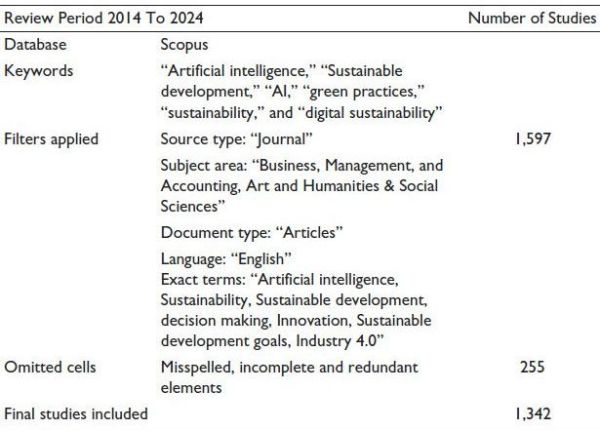
Publication Pattern
A publishing performance technique was utilized to admire the progress of AI and sustainability publications in research articles between 2014 and 2024. The findings highlight a steady rise in AI adoption in sustainable practices research across various industries.
It can be observed that the advancement of AI and sustainability research tended to stagnate in 2014–2018 (Figure 1). In 2019, there was a significant rise in research on AI sustainability, which continued with more publications in 2020 and subsequent years. Academic interest in AI and sustainability is rising due to regulatory frameworks such as EU AI Act, UN-SDGs and AI’s role in tackling climate challenges (Singh et al., 2024).
Publications’ Performance
In the next stage of bibliometric analysis, the Biblioshiny application was employed to perform citation analysis, highlighting the performance of journals and articles. The analysis is divided into two categories: Journal performance and article performance.
Journal Performance
Table 2 highlights the count of AI and sustainability-related articles published across various Scopus-indexed journals. Sustainability (Switzerland) topped the list with 457 articles, followed by Journal of Cleaner Production with 90. Other notable journals include Sustainable Cities and Society and Technological Forecasting and Social Change, which have 39 and 33 articles, respectively. This distribution reflects a diverse academic interest in AI and sustainability, encompassing fields such as sustainability, technology, and social change.
Figure 1. Publication Trend and Sustainability (2014–2024).
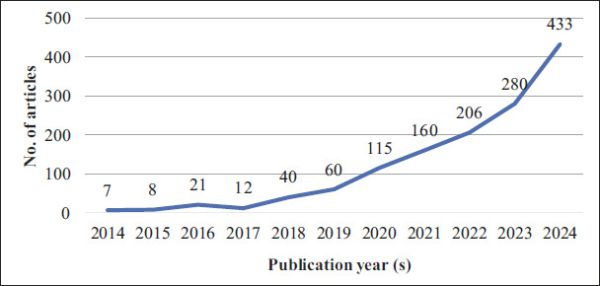
Table 2. Top 10 Marketing Journals.
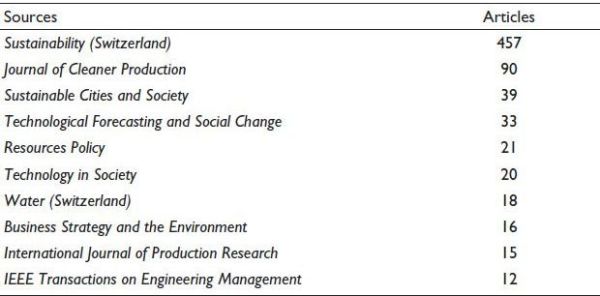
Articles Performance
Article performance was measured through citation analysis, focusing on two key types of citations: Local and global. Local citations capture how frequently articles within the review corpus (such as the 1,342 articles sourced from Scopus) cite one another. Global citations, on the other hand, show the overall number of instances an article is cited in the review corpus as well as by other sources (Kumar et al., 2021). Although the Biblioshiny failed to record any local citations, it revealed that one article (Table 3) received the highest global recognition, amassing 933 citations from both within and outside the 1,342 articles reviewed written by Kusiak (2018), applied the concepts of cyber-physical systems which are powered by technologies like the IOTs, cloud computing, service-oriented computing, AI, and data science. Allam and Dhunny (2019) examined the urban potential of AI and introduced a new framework that integrates AI technology with cities emphasizing the incorporation of key cultural dimensions with 709 citations. Di Vaio et al. (2020) study, “Artificial Intelligence and Business Models in the Sustainable Development Goals Perspective: A Systematic Literature Review” ranked third with 550 citations, emphasized the connections among AI, speedy technological advancements, and sustainable growth. “Artificial Intelligence for Sustainability: Challenges, Opportunities, and a Research Agenda” written by Elia et al. (2020) with 470 citations, explored human and social issues while offering a clear path for AI research and advancements. Bag et al. (2021) in their study with 465 citations, examined how auto companies leverage physical resources and labor capabilities to enable technology while promoting environmentally conscious production. Similarly, Ahad et al. (2020), with 384 citations explored and thoroughly examined the role of enabling technologies in smart cities.
Table 3. Top Influential Articles on AI and Sustainability.
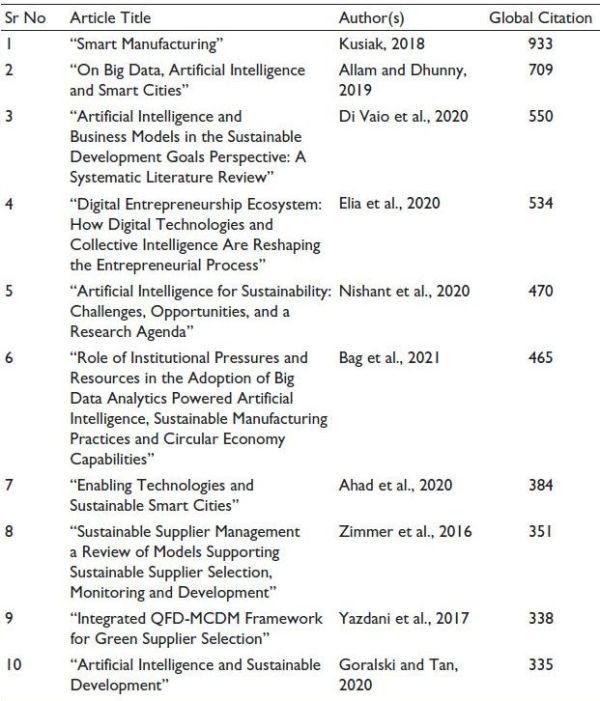
Zimmer et al. (2016), with 351 citations, analyzed scientific literature on sustainable supplier management (SSM) emphasizing formal models that support decision-making. Yazdani et al. (2017) focused on a comprehensive approach to green supplier selection, considering multiple environmental performance criteria and requirements. Goralski and Tan (2020) investigated how AI is changing business, government, and society with 335 citations.
Contributors’ Performance
Following the analysis of publication trends and performance, the next phase of the bibliometric study shifts to evaluating the performance of contributors, including both authors and countries. In this study, contributor performance is measured through two key factors: productivity, measured by the research articles produced by an author or nation and citations earned through their works. The findings of this investigation are explored in two separate sections: author performance and country performance.
Author Performance
Table 4 exhibits 10 of the most influential authors in the realm of AI and sustainability research. LIU Y leads with a total of 16 publications, marking them as the foremost contributor. The main theme of Liu Y’s work focuses on combining digital technology and green solutions to tackle environmental challenges and promote sustainability. Chen Y, Wang J, and Wang X are close second with 10 publications each. Chen Y’s research primarily explores the implementation of diverse AI technologies across various industries to achieve and sustain environmental and economic sustainability. The primary focus of studies by Wang J and Wang X has been to examine the key factors influencing AI adoption for sustainable development, addressing the perspectives of both consumers and policymakers. Other prominent authors in this field include Wang y (10 publications), Gupta S and Kumar A (9 publications each), Chatterjee S, Li J, and Zhang Y (8 publications each). These authors collectively drive the discourse on AI and sustainability through their extensive research efforts.
Country’s Performance
Table 5 provides a country-wise analysis of total citations and average article citations. China stands out with 3,738 citations and an average of 17.20 citations per article, showcasing its leading role in this field. Italy follows with 3,112 citations and an average of 50.20 citations per article, indicating its growing influence. The United Kingdom also makes a significant contribution with 2,756 citations and an average of 46.70 citations per article. USA has 2,678 citations with an average citations per article 46.60, reflecting the high impact of its research. Australia, Germany, and Spain also play significant roles, with average citations per article ranging from 51.20 to 28.70, indicating their active participation in AI and sustainability studies. Korea, India, and Canada, while having fewer total citations, still show strong average citations per article, underscoring the relevance of their research. This diverse international representation highlights the global importance of AI and sustainability research and the collaborative efforts to advance knowledge in these areas.
Table 4. Most Influential Authors.
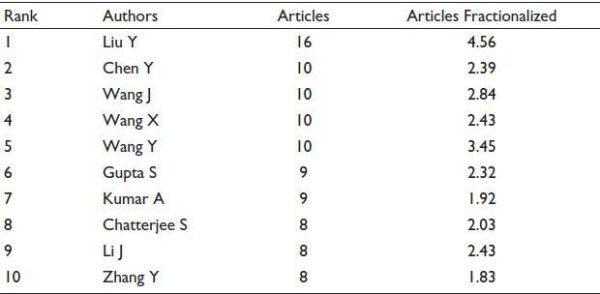
Table 5. Most Cited Countries in the Field.
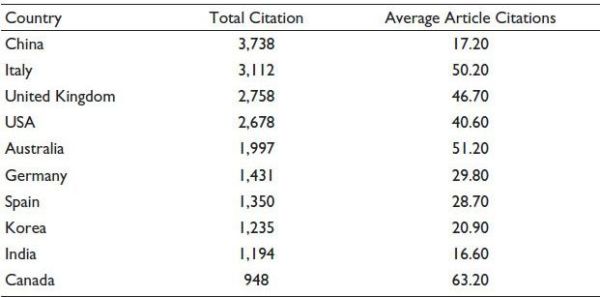
Conceptual Structure
The fourth stage of bibliometric analysis explored the conceptual structure of AI and sustainability research using 1,342 articles and co-word analysis through the Biblioshiny application. This structure identifies connections between key concepts in the field. Keyword co-occurrence analysis was primarily utilized to identify future research themes and construct this framework. The results are outlined in the next sections: Keyword co-occurrence analysis.
Keyword Co-occurrence Analysis
A review corpus of 1,342 articles was used to study keyword co-occurrence and build the conceptual structure. The analysis focused on authors’ keywords, grouping them in clusters on the basis of shared themes. This helped identify key themes within the clusters that received significant attention.
Figure 2 shows that the keywords are grouped into two clusters, each marked by a different color. These clusters represent themes in AI and sustainability research across various industries, which are discussed in detail.
Cluster 1 (Red Color): Drivers of AI Adoption for Sustainability
The keywords analysis for Cluster 1, highlighted in red (Figure 2), reveals that studies in the area of AI and sustainability primarily focus on various aspects that influence, in one way or another, the acceptance or usage of AI in promoting sustainable practices across diverse contexts.
Figure 2. Keyword Co-occurrence Analysis.
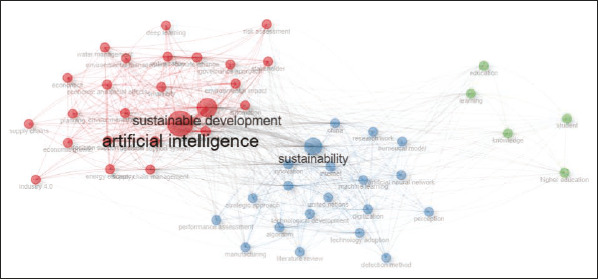
Source: Authors’ Extraction from Biblioshiny application.
Remarks: Every node indicates a keyword, and the connection between them indicates how often the keywords co-occur. Thicker lines indicate more frequent co-occurrence. Circles that are in proximity indicate a stronger association between the keywords, and their colors represent the clusters they belong to.
AI has become a revolutionary factor in a variety of industries, driving significant advancements and yielding substantial benefits. Various researchers explore different concepts as drivers or motivators, such as technological capability, innovation investment, environmental awareness, perceived responsibility for the environment, sustainable choices, AI-powered risk mitigation, green innovation, sustainable performance, AI capability, innovative culture, artificial intelligence management, knowledge sharing, etc.
Cluster 2 (Blue Color): AI-driven Sustainability Across Domains
The analysis of keywords in Cluster 2, highlighted in blue (Figure 2), indicates that AI and sustainability research primarily focuses on its applicability across various sectors such as fashion, tourism, manufacturing and energy. The coronavirus pandemic disrupted supply chains and exposed vulnerabilities, highlighting the potential of advanced technologies and their collaboration to mitigate these challenges. Using technology to boost sustainable fashion can create new opportunities for growth and innovation in the post-pandemic era. In Human Resource Management, the capabilities of Smart Technology, AI, Robotics, including Algorithms, have influenced Green HRM practices and environmentally friendly outcomes in the manufacturing sector. Leveraging Generative AI, natural language processing, and the Internet of Things enhances the efficiency of decision-making and travel organizing in smart tourism destinations. Technologies like AI, IoT, and DLT could completely change how energy systems work in the future.
Cluster 3 (Green Color): AI for Sustainable Learning
The keyword analysis for Cluster 3, shown in green (Figure 2), shows that AI research is mainly focused on its use in digital learning. While the SDGs are widely acknowledged but there has still been a paucity of research on how educational programs help students understand and commit to them. Implementing environmental sustainability through the adoption of AI in colleges and universities is a lengthy endeavor that requires both financial as well as human capital. AI-supported learning promotes environmental responsibility, increases availability and reduces ecological damage by maximizing resources and reducing the utilization of tangible resources. Students acknowledge the efficiency of AI but worry about its effects on learning quality and academic integrity. Higher education institutions must create educational policies that encourage the incorporation of AI while ensuring its moral execution.
Discussion and Conclusion
This study provides a critical assessment of the application of AI across different sectors and identifies potential domains for further inquiry through the organization of existing research. For this study, a bibliometric analysis was conducted on 1,342 articles on AI adoption while ensuring sustainability published during 2014 and 2024 in the database of Scopus. The findings indicate a notable increase in literature on AI and sustainability across several industries, particularly since 2019. Furthermore, this publication trend revealed that studies on AI and sustainability is suitable for publication not only in marketing journals but also in journals from other fields, like Sustainability (Switzerland) (414 articles) and Journal of Cleaner Production with 90, and Sustainable Cities and Society with 39 were the most popular. It is essential to remember that the writing style and research focus are critical for establishing an effective presence in the field. A robust as well as well-detailed article is essential for successful publication and generating citations.
Additionally, the analysis of contributors’ performance revealed Liu Y as the most prolific author, having 16 publications. The focused area of Liu Y was to investigate the effect of artificial intelligence, transformation and managerial innovation on efficiency and long-term development, specifically in emerging economies like China.
In terms of contributions by countries, developed economies, including China, Italy, the United States, and the United Kingdom, are at the leading edge of AI and sustainability research, reflecting their advanced regulatory frameworks and growing demand for sustainable innovations. In contrast, developing nations like India and Canada are becoming key contributors.
The keyword co-occurrence analysis in the last stage of bibliometric analysis revealed three distinct clusters, each shows various concepts and their importance in the field. The main themes of identified clusters are factors that influence the adoption of AI and sustainability, AI and sustainability application across industries, such as fashion, tourism, and energy, and AI application in digital learning. These conceptual clusters identified by keyword analysis serve as a strategic guide for both corporate and public organizations, supporting them in combining technological initiatives with overall sustainability goals.
Specifically in the Indian context, as highlighted in Table 5, the country has made great progress as an emerging contributor in the combined field of AI and sustainability. With a total of 1,194 citations and an average of 16.60 citations per article, India is increasingly gaining recognition in this evolving research domain. Leading this scholarly activity are authors such as Gupta S and Kumar A, each with nine publications, and Chatterjee S, with eight publications, as shown in Table 4. These authors are pioneering research into the intersection of AI and sustainability within the Indian context.
However, it is pertinent to point out that while the collaboration between AI and sustainability is still in its initial phase, it represents a rapidly growing field of enquiry that needs further investigation and focused efforts, especially in developing nations like India. The potential of AI to drive sustainability solutions is immense, but it is essential to continue further study in this domain to fully harness its capabilities.
Although this article offers valuable insights into the current landscape of AI and sustainability research, yet is not without limitations. These limitations are acknowledged in the following sections, along with suggestions for potential areas of future research. Expanding the scope of collaboration, increasing investment in AI technologies, and addressing the gaps in knowledge will be crucial for advancing this interdisciplinary field, particularly in developing economies such as India.
Future Directions of the Study
According to the study’s conclusion and existing literature, some potential fields for further research are: First, future studies should move beyond simply understanding the potential impacts of AI in a single field, to exploring both its positive and negative consequences across social, environmental, and economic dimensions.
Second, there has not been enough or little research conducted on teaching and learning. The extensive application of AI technology in actual teaching and learning could be explored in further studies.
Third, most research is focused on fashion, tourism, manufacturing and energy services. However, there is less research that focuses on wholesale trading, mining, fishing, agriculture, forestry, and public administration, which could be explored more in further research with regard to their application in the field of AI and sustainability.
Fourth, future researchers could study the comparison of developing and developed countries with respect to this interaction to make their findings more impressive.
Limitations
Despite the theoretical contributions of the study, there are still a few limitations related to its approach. First, the Scopus database was the only source of data utilized in the study. While the use of Scopus has been justified, there is a chance that some relevant articles from other databases were overlooked. Therefore, future reviews on AI and sustainability should consider including articles from these databases to either support or challenge the findings of this review. Second, due to the large volume of research articles on this topic, we limited the study to articles published in the past 10 years. This could present an opportunity for future research to explore earlier works in the field.
Declaration of Conflicting Interests
The authors declared no potential conflicts of interest with respect to the research, authorship, and/or publication of this article.
Funding
The authors received no financial support for the research, authorship, and/or publication of this article.
Ahad, M. A., Paiva, S., Tripathi, G., & Feroz, N. (2020). Enabling technologies and sustainable smart cities. Sustainable Cities and Society, 61, 102301.
Ali, Z. A., Zain, M., Pathan, M. S., & Mooney, P. (2024). Contributions of artificial intelligence for circular economy transition leading toward sustainability: an explorative study in agriculture and food industries of Pakistan. Environment, Development and Sustainability, 26(8), 19131–19175.
Allam, Z., & Dhunny, Z. A. (2019). On big data, artificial intelligence and smart cities. Cities, 89, 80–91.
Bag, S., Pretorius, J. H. C., Gupta, S., & Dwivedi, Y. K. (2021). Role of institutional pressures and resources in the adoption of big data analytics powered artificial intelligence, sustainable manufacturing practices and circular economy capabilities. Technological Forecasting and Social Change, 163, 120420.
Balcıoğlu, Y. S., Çelik, A. A., & Altındağ, E. (2024). Artificial intelligence integration in sustainable business practices: A text mining analysis of USA firms. Sustainability, 16(15). https://doi.org/10.3390/su16156334
Bolón-Canedo, V., Morán-Fernández, L., Cancela, B., & Alonso-Betanzos, A. (2024). A review of green artificial intelligence: Towards a more sustainable future. Neurocomputing, 599. https://doi.org/10.1016/j.neucom.2024.128096
Boons, F., & Lüdeke-Freund, F. (2013). Business models for sustainable innovation: State-of-the-art and steps towards a research agenda. Journal of Cleaner Production, 45, 9–19.
Boustani, N. M., Sidani, D., & Boustany, Z. (2024). Leveraging ICT and generative AI in higher education for sustainable development: The case of a Lebanese private university. Administrative Sciences, 14(10). https://doi.org/10.3390/admsci14100251
Carruthers, D. (2001). From opposition to orthodoxy: The remaking of sustainable development. Journal of Third World Studies, 18(2), 93–112.
Di Vaio, A., Palladino, R., Hassan, R., & Escobar, O. (2020). Artificial intelligence and business models in the sustainable development goals perspective: A systematic literature review. Journal of Business Research, 121, 283–314.
Donthu, N., Kumar, S., Mukherjee, D., Pandey, N., & Lim, W. M. (2021). How to conduct a bibliometric analysis: An overview and guidelines. Journal of Business Research, 133, 285–296. https://doi.org/10.1016/j.jbusres.2021.04.070
Duan, Y., Edwards, J. S., & Dwivedi, Y. K. (2019). Artificial intelligence for decision making in the era of big data: Evolution, challenges and research agenda. International Journal of Information Management, 48, 63–71.
Elia, G., Margherita, A., & Passiante, G. (2020). Digital entrepreneurship ecosystem: How digital technologies and collective intelligence are reshaping the entrepreneurial process. Technological Forecasting and Social Change, 150, 119791.
Espinoza Vidaurre, S. M., Velásquez Rodríguez, N. C., Gambetta Quelopana, R. L., Martinez Valdivia, A. N., Leo Rossi, E. A., & Nolasco-Mamani, M. A. (2024). Perceptions of artificial intelligence and its impact on academic integrity among university students in Peru and Chile: An approach to sustainable education. Sustainability, 16(20). https://doi.org/10.3390/su16209005
Gajić, T., Ranjbaran, A., Vukolić, D., Bugarčić, J., Spasojević, A., Đorđević Boljanović, J., Vujačić, D., Mandarić, M., Kostić, M., Sekulić, D., Bugarčić, M., Drašković, B. D., & Rakić, S. R. (2024). Tourists’ willingness to adopt AI in hospitality: Assumption of sustainability in developing countries. Sustainability, 16(9). https://doi.org/10.3390/su16093663
Goralski, M. A., & Tan, T. K. (2020). Artificial intelligence and sustainable development. The International Journal of Management Education, 18(1), 100330.
Hariyani, D., Hariyani, P., Mishra, S., & Sharma, M. K. (2024). Leveraging digital technologies for advancing circular economy practices and enhancing life cycle analysis: A systematic literature review. Waste Management Bulletin, 2(3), 69–83.
Khalid, J., Chuanmin, M., Altaf, F., Shafqat, M. M., Khan, S. K., & Ashraf, M. U. (2024). AI-driven risk management and sustainable decision-making: Role of perceived environmental responsibility. Sustainability, 16(16). https://doi.org/10.3390/su16166799
Kumar, A., Singh, P., Raizada, P., & Hussain, C. M. (2022). Impact of COVID-19 on greenhouse gases emissions: A critical review. Science of the Total Environment, 806, 150349.
Kumar, S., Lim, W. M., Pandey, N., & Westland, J. C. (2021). 20 years of electronic commerce research. Electronic Commerce Research, 21(1), 1–40.
Kusiak, A. (2018). Smart manufacturing. International Journal of Production Research, 56(1–2), 508–517.
Lukic Vujadinovic, V., Damnjanovic, A., Cakic, A., Petkovic, D. R., Prelevic, M., Pantovic, V., Stojanovic, M., Vidojevic, D., Vranjes, D., & Bodolo, I. (2024). AI-driven approach for enhancing sustainability in urban public transportation. Sustainability, 16(17), 7763. https://doi.org/10.3390/su16177763
Min, X., Shen, L., & Ren, X. (2024). The role of clothing technology in supporting sustainable fashion in the post-COVID-19 era. Sustainability, 16(19). https://doi.org/10.3390/su16198287
Nishant, R., Kennedy, M., & Corbett, J. (2020). Artificial intelligence for sustainability: Challenges, opportunities, and a research agenda. International Journal of Information Management, 53, 102104.
Prahani, B., Rizki, I., Jatmiko, B., Suprapto, N., & Tan, A. (2022). Artificial intelligence in education research during the last ten years: A review and bibliometric study. International Journal of Emerging Technologies in Learning, 17(8), 169–188.
PwC Analysis. (n.d.). Sizing the prize: What’s the real value of AI for your business how can you capitalise? Retrieved, 6 May 2025, from https://www.pwc.com/gx/en/issues/analytics/assets/pwc-ai-analysis-sizing-the-prize-report.pdf
Raman, R., Gunasekar, S., Kaliyaperumal, D., & Nedungadi, P. (2024). Navigating the nexus of artificial intelligence and renewable energy for the advancement of sustainable development goals. Sustainability, 16(21). https://doi.org/10.3390/su16219144
Rane, N. L., Kaya, Ö., & Rane, J. (2024). Advancing the sustainable development goals (SDGs) through artificial intelligence, machine learning, and deep learning. In Artificial Intelligence, Machine Learning, and Deep Learning for Sustainable Industry 5.0. Deep Science Publishing. https://doi.org/10.70593/978-81-981271-8-1_4
Singh, A., Kanaujia, A., Singh, V. K., & Vinuesa, R. (2024). Artificial intelligence for Sustainable Development Goals: Bibliometric patterns and concept evolution trajectories. Sustainable Development, 32(1), 724–754. https://doi.org/10.1002/sd.2706
Su, H., & Mokmin, N. A. M. (2024). Unveiling the canvas: Sustainable integration of AI in visual art education. Sustainability, 16(17), 7849. https://doi.org/10.3390/su16177849
Tabbakh, A., Al Amin, L., Islam, M., Mahmud, G. I., Chowdhury, I. K., & Mukta, M. S. H. (2024). Towards sustainable AI: A comprehensive framework for Green AI. Discover Sustainability, 5(1), 408.
Tang, M., Liao, H., Wan, Z., Herrera-Viedma, E., & Rosen, M. A. (2018). Ten years of sustainability (2009 to 2018): A bibliometric overview. Sustainability, 10(5), 1655.
Tiwary, N. K., Kumar, R. K., Sarraf, S., Kumar, P., & Rana, N. P. (2021). Impact assessment of social media usage in B2B marketing: A review of the literature and a way forward. Journal of Business Research, 131, 121–139.
Yazdani, M., Chatterjee, P., Zavadskas, E. K., & Zolfani, S. H. (2017). Integrated QFD-MCDM framework for green supplier selection. Journal of Cleaner Production, 142, 3728–3740.
Zimmer, K., Fröhling, M., & Schultmann, F. (2016). Sustainable supplier management: A review of models supporting sustainable supplier selection, monitoring and development. International Journal of Production Research, 54(5), 1412–1442.